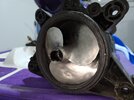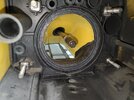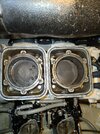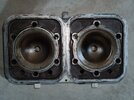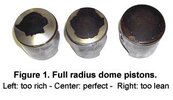I recently bought a 1995 Sea-Doo HX. It's got aftermarket handlebars, FPP pipes, and an aftermarket flame arrestor in place of the stock air filter. The guy I bought it from only ever used non-ethanol fuel in it (actually mixed 91 and 110 in a 4:1 ratio, no idea why as the manual doesn't call for anything that high). I don't have access to 110 easily, so I put 91 non-ethanol in it (the manual only calls for 87).
The ski ran perfectly fine my first few times out, though it seemed to be rather hard to start after the first ride of the day. No hesitation that first time, but any time after that would require playing with the choke and throttle to get it to fire up. It also tended to be stuck at an idle, refusing to go above that for up to a minute or so after starting regardless as to the throttle. No idea why it's doing that, but once it started running normally again it would run fine until I fell off or shut it down again. After reading about the fuel lines in these things I decided to take one off and see what it looked like inside. Replaced the original grey tempo line with some regular black automotive line, then cut open the old one and saw it was pristine inside. The non-ethanol fuel must have prevented the decay typically seen.
The next time I took it out it stopped starting entirely, with the solenoid just going "click" when the button was pressed. Ended up putting a new battery in it, as I'd thought it was bad. Turned out that wasn't the problem though. Replaced the solenoid as well, and that didn't fix it. Put new plugs in it (gapped to the proper amount), because why not? Ended up being the starter itself, which was filled with black dust and had basically no brushes left. Replaced the starter, and it ran again.
Now we get to the present issue - I took it out again this last weekend and it ran great for around an hour. Still had difficulty starting, but otherwise ran normal once it was up and moving. Then I was cruising along, at maybe a third throttle (and had been leisurely doing so for a good ten minutes) and all of a sudden it slowed to an idle and then stopped in just a couple seconds. Completely shut down, and just went "click" every time I pushed the button. When I got home, it still wouldn't start. Ended up taking the spark plugs out and.. bam! Cranks over fine. Put the plugs back in, and nothing. Just click. Take one plug out (either one, makes no difference) and it'll run fine on one cylinder. After it cooled down, it runs fine with both plugs in again.
In this time I'd noticed that I'd burned little (or maybe even no) oil, despite burning through around an entire tank of gas. I'm not sure if I should have noticed any drop in the oil in that time or not, but I figured I'd go ahead and disable the oil pump. I pulled the carbs off, then the intake manifold, and pulled the nylon gear out. Left the pump on, because why not? It's basically just a block off plate without the gear driving it. All the oil lines are still connected, so the rotary valve is still getting oil. Opened the carbs up and found the filters and needles to be perfectly clean, nothing noticeably wrong with them. Put it all back together, and took it out to the lake to test. Just slowly moved around at a quarter throttle or so for maybe 10 minutes.. and bam, shut down on me and just goes "click".
Took it home, pulled the plugs.. cranks over fine. No fluid on the plugs, nothing coming out of the holes. Put one in, and it runs on one. Both in, nothing. Engine is uncomfortably warm to touch, but not burning. Same temperature on all sides. Put the thing away for the afternoon. Came back out a few hours later, pushed the button.. instantly starts with zero throttle or choke. No hesitation at all.
I'm at a loss. What could possibly be causing the engine to basically seize up, but only when hot.. and unseize and work just fine until it gets hot?
The ski ran perfectly fine my first few times out, though it seemed to be rather hard to start after the first ride of the day. No hesitation that first time, but any time after that would require playing with the choke and throttle to get it to fire up. It also tended to be stuck at an idle, refusing to go above that for up to a minute or so after starting regardless as to the throttle. No idea why it's doing that, but once it started running normally again it would run fine until I fell off or shut it down again. After reading about the fuel lines in these things I decided to take one off and see what it looked like inside. Replaced the original grey tempo line with some regular black automotive line, then cut open the old one and saw it was pristine inside. The non-ethanol fuel must have prevented the decay typically seen.
The next time I took it out it stopped starting entirely, with the solenoid just going "click" when the button was pressed. Ended up putting a new battery in it, as I'd thought it was bad. Turned out that wasn't the problem though. Replaced the solenoid as well, and that didn't fix it. Put new plugs in it (gapped to the proper amount), because why not? Ended up being the starter itself, which was filled with black dust and had basically no brushes left. Replaced the starter, and it ran again.
Now we get to the present issue - I took it out again this last weekend and it ran great for around an hour. Still had difficulty starting, but otherwise ran normal once it was up and moving. Then I was cruising along, at maybe a third throttle (and had been leisurely doing so for a good ten minutes) and all of a sudden it slowed to an idle and then stopped in just a couple seconds. Completely shut down, and just went "click" every time I pushed the button. When I got home, it still wouldn't start. Ended up taking the spark plugs out and.. bam! Cranks over fine. Put the plugs back in, and nothing. Just click. Take one plug out (either one, makes no difference) and it'll run fine on one cylinder. After it cooled down, it runs fine with both plugs in again.
In this time I'd noticed that I'd burned little (or maybe even no) oil, despite burning through around an entire tank of gas. I'm not sure if I should have noticed any drop in the oil in that time or not, but I figured I'd go ahead and disable the oil pump. I pulled the carbs off, then the intake manifold, and pulled the nylon gear out. Left the pump on, because why not? It's basically just a block off plate without the gear driving it. All the oil lines are still connected, so the rotary valve is still getting oil. Opened the carbs up and found the filters and needles to be perfectly clean, nothing noticeably wrong with them. Put it all back together, and took it out to the lake to test. Just slowly moved around at a quarter throttle or so for maybe 10 minutes.. and bam, shut down on me and just goes "click".
Took it home, pulled the plugs.. cranks over fine. No fluid on the plugs, nothing coming out of the holes. Put one in, and it runs on one. Both in, nothing. Engine is uncomfortably warm to touch, but not burning. Same temperature on all sides. Put the thing away for the afternoon. Came back out a few hours later, pushed the button.. instantly starts with zero throttle or choke. No hesitation at all.
I'm at a loss. What could possibly be causing the engine to basically seize up, but only when hot.. and unseize and work just fine until it gets hot?




